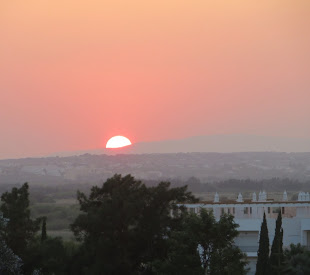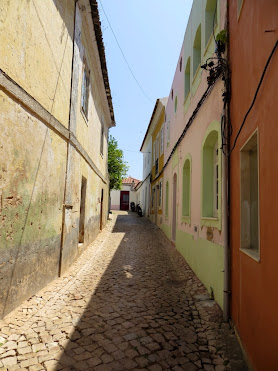The day i was leaving Lisbon there was some concern as to whether i would get transportation out or not - there was to be general strike (apparently these happen often). I already had purchased my bus ticket to Vilamoura in the Algarve and Esmerelda (the contact for our accommodation in Lisbon) came to the apartment to help me with my bags and get me a taxi to the bus station. I had a comfortable 3.5 hour journey to Vilamoura. The bus dropped me off about a 5 minute walk from my accommodation. I found the 2 bedroom accommodation on the Internet 350 euro for 5 nights - the lady said since I was a single traveler I could have it for 250 euro. Then she contacted me to say the kitchen was being renovated and I would not have a cooker (stove) for the first couple of days and there would be a workman there to finish the job but if I still wanted the accommodation I could have it for 150 euro for 5 nights which works out to be about $40 a night. When I arrived the place was dusty and messy from the renovations but there was a cleaner tidying the place - small inconvenience for such a great rate and a lovely apartment with a balcony.
In the algarve wherever you look, the colours of the mountains and sea are always with you, creating the impression of a water-colour dotted with highlights of gold, green and blue. The region is an extensive and pleasant one, with a Mediterranean climate, marked by the smell of the sea at low tide and the scent of wild flowers. The weather is in the low 30's most days and it cools to the low 20's in the evening
A stroll through the tangled web of narrow streets, alleys and steps to be found away from the coast is the best way of getting to know this part of the region. But you can also easily lose yourself in the vastness of the coastal strip. Here the backdrop is composed of some of Europe's most beautiful beaches, from where you can admire the rocky coastline and the playful shadows they cast on the sand.
Vilamoura is one of the top vacation spots in Europe. It is very clean and beautiful with a lovely marina where numerous shops and outdoor restaurants are located. It is truly a little paradise - expensive by Portuguese terms but relatvely cheap compared to North America. Vilamoura being a resort area does not look like the quaint European villages you imagine when you think of Portugal. More like an upscale Waikiki - I have never seen so many expensive boats in one place! Nor I have ever seen so many jags, Audis, BMW's and Mercedes.
The restaurants may look empty now but come 9pm everywhere is packed - everyone also dresses up for dinner - no shorts, capris etc. The Portuguese eat around 9 or 10 pm, have a few drinks, go to the discos around midnight and some bars and discos stay open until 6am. As you might imagine the only people up and about in the morning are tourists and Portuguese who must work to feed tourists - most stores do not open until 10 am or later.
I met up with Sharon (the irish girl I traveled with through Cambodia) as she is vacationing here with a couple of girl friends and is staying only about a 40minute walk from me. The first couple of days I have done lots of walking, laying on the beach and more walking! Getting quite brown (well more reddish brown at the moment). We went out to a restaurant called BenBom a Brazilian type cuisine where lots of BBQ meats are served - it was delicious.
I rented a car to explore the Algarve area. First stop was Tavira which is a beautifully elegant town and almost surreal in aspects. Much more in the true characteristic of a European village with its narrow stone streets lined with houses often covered with decorative tiles. Between the 8th and 13th centuries Tavira was under Arab rule until its conquest by the Knights of the Order of Santiago in 1242. It was elevated to a city in 1520 by King Manuel I and was the main trading port in the Algarve during the 16th to 18th centuries.
Today it has still managed to stave off the influence of tourism to hold on to its unique tradition and handsome character. The seven arch bridge, over the river Gilão, is reputedly Roman in origin, although its present appearance was acquired in the 17th century. Since severe floods affected the bridge in 1989 it has only been open to pedestrians.
The market hall ( large suare in the centre of the town) on the river front was re-vamped a few years ago and now is 'home' to several shops, cafes and restaurants around the edge with the central space available for exhibitions and special events.
This stretch of river front along the Gilão River is a great place to sit at one of the cafes and enjoy the very picturesque setting. We enjoyed a lovely dinner beside the river - I has grilled swordfish and it tasted exceptional good - nice to be eating fresh food! We wandered around Tavira so long that it was 10:30 pm before we knew it and I had to drive back to Vilamoura in the dark - at least I am driving on the right hand side of the road.
The next day we drove to Lagos but on our way we detoured to visit Silves. It was Sunday morning and the town was very quiet with only a few tourists and fewer locals.
Silves is an enchanting town littered with orange and lemon trees, sitting on the banks of the Arade River. There is history everywhere you look in Silves, to remind you of its affluent and bold past as a Moorish capital. The importance of Silves lay in the fact that it was the main access to the inland areas of the Algarve because of its river location, although the river is now too silted up for large vessels to use.
The most prominent monument is Castelo de Silves, which is now the best preserved castle in the Algarve. The castle and the Cathedral beside it are the first buildings you see as you approach Silves, as they sit on the hilltop above the town. We walked around the town in extreme heat, enjoyed a coffee and the off to Lagos.
The older part of Lagos is still circled by the city walls that were constructed during the 16th century when it was the residence of the governors of the Algarve and the fort, Ponta da Bandeira, by Batata beach is part of the 17th century fortifications that were added to protect the town. The city was virtually destroyed by the 1755 earthqake in Portugal.
The square next to the Governors' castle is the Praça Infante Dom Henrique with a statue of Prince Henry looking out to sea. To the left of the square at the back is Igreja da Santa Maria. The facade of this church is 15/16th century but it was rebuilt in the 18/19th centuries.
Walk along the cobbled street at the back of the square just past Santa Maria church and you come to the famous Lagos 'golden church' of St. Anthony which was rebuilt in 1769. On the opposite side to the churches is the 'Slave Market' from the 15th century, where slaves brought back from the discovery voyages were sold.
Lovely quaint, picturesque town with its narrow streets, squares, marina and beaches - I was only sorry we did not have more time to spend here.








































No comments:
Post a Comment